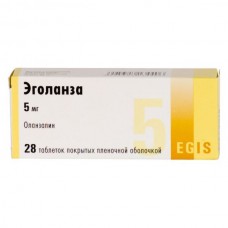Expiration date: 03/2025
Release Form
Tablets film-coated
Composition
One tablet contains 5 or 10 mg of olanzapine.
Packaging
28 pcs.
Pharmachologic effect
Egolanza - antipsychotic (neuroleptic) the ATX code: N05A H03 Olanzapine is an antipsychotic (neuroleptic) with a wide spectrum of pharmacological effects on a number of receptor systems. It has an affinity with serotonin (5-HT2A / C 5NTZ, 5NT6), dopamine (D1, D2, D3, D4, D5), muscarinic (M1-5), adrenergic (alpha 1) and histamine (H1) receptor. Revealed antagonism to serotonin (5HT), dopamine, and cholinergic receptors. Has a pronounced affinity and activity against 5NTt serotonin receptors in comparison with dopamine D2 receptors. Meyulimbicheskih selectively reduces anxiety (A10) dopaminergic neurons, has little effect on striatal (A9) nerve pathways involved in the regulation of motor function. Reduces conditioned defensive reflex in lower doses than the dose causing catalepsy. It enhances the anti-anxiety effect during "anxiolytic" test. Significantly reduces productivity (including delusions, hallucinations) and negative symptoms.
Testimony
Schizophrenia (aggravation, maintenance and long-term preventive treatment). Bipolar disorder (monotherapy or in combination with drugs or Li + valytroevoy acid): acute manic or mixed episodes with / without psychotic symptoms and with / without rapid phase shifts.
Recurrence of bipolar disorder and the prevention of recurrence of bipolar disorder (for efficacy in the treatment of the manic phase).
Contraindications
Hypersensitivity to the active agent or any of the components. Angle-closure glaucoma. Psychosis and / or behavioral disturbances associated with dementia. Lactation. Children's age (up to 18 years due to insufficient clinical data). Lactose intolerance, lactase deficiency or glucose-galactose malabsorption (product contains lactose).
Carefully
Liver failure, renal failure, prostatic hyperplasia, epilepsy, convulsions in history, myelosuppression (including leukopenia, neutropenia). myeloproliferative disorders, hypereosinophilic syndrome, paralytic ileus, pregnancy, cardiovascular and cerebrovascular disease, or other conditions predisposing to hypotension, inherent increase in the QT interval on the electrocardiogram (ECG) (increasing corrected, QT interval (the QTc) on the ECG), or nachichii conditions with the potential to cause an increase in intervata QT (for example, co-administration of drugs prolonging the QT interval, congestive heart failure, hypokalemia, hypomagnesemia), advanced age, and concomitant use of other drugs of the central action, immobilization.
Pregnancy and breast-feeding
Strictly controlled clinical studies of the safety of olanzapine during pregnancy was conducted. Application is possible only in cases when the expected advantage of therapy for mother considerably exceeds the potential risk to the fetus.
Olanzapine may be excreted in breast milk. Not recommended breastfeeding during therapy drug Egolanza.
Dosing and Administration
Inside, regardless of meals, once - 5-20 mg / day. In schizophrenia in adults recommended initial dose - 10 mg / day. In acute mania associated with bipolar disorder in adults - 15 mg / day (1x) alone or 10 mg / day (1 time) in combination with drugs Li + or valproic acid (maintenance therapy at the same dose).
Prevention of relapse of bipolar disorder: The recommended starting dose is 10 mg per day. Patients previously treated with olanzapine for the treatment of manic episode should continue treatment at the same dose for relapse prevention. In the presence of a new manic, mixed, or depressive episode olanzapine should continue (if necessary specifying dose) in the presence of clinical indications should be added to appoint agents to eliminate mood disorders.
In the treatment of schizophrenia, manic episode and for the prevention of recurrence of bipolar disorder, the daily dose may subsequently be adjusted within the range of 5 to 20 mg based on the clinical condition of the particular patient. Dose adjustment over a value recommended as the initial dose, is recommended only after careful clinical analysis, and should usually occur at intervals of at least 24 hours.
Prior to discontinuation of olanzapine should gradually reduce the dose. The maximum daily dose of olanzapine 20 mg.
Side effects
From the nervous system and sensory organs: dizziness, headache, migraine, weakness, fatigue, drowsiness, insomnia, anxiety, hostility, agitation, euphoria, amnesia, depersonalization, phobia, obsessive-compulsive symptoms, neuralgia, facial nerve paresis, hypoesthesia, extrapyramidal disorders, including tardive dyskinesia, ataxia, stiff neck, muscle twitching, tremor, akathisia, dysarthria, stuttering, syncope, delirium, suicidal tendencies, stupor, coma, subarachnoid hemorrhage, stroke, nystagmus, diplopia, mydriasis, pigment deposition in the lens, cataract, xerophthalmia, bleeding in the eye, a violation of accommodation, amblyopia, glaucoma, corneal lesion, eye pain, keratoconjunctivitis, blepharitis, noise and pain in the ears, hearing loss, impaired sense of taste.
Cardio-vascular system and blood (blood, hemostasis): orthostatic hypotension, and bradycardia, tachy, palpitations, ventricular arrythmia, ECG changes, cardiac arrest, cyanosis, vasodilation, transient leuko- and neutropenia, eosinophilia, leukocytosis, thrombocytopenia, hemorrhagic syndrome.
From the respiratory system: rhinitis, pharyngitis, laryngitis, voice changes, increased cough, dyspnea, sleep apnea, asthma, hyperventilation.
From the digestive tract: increased appetite until bulimia, thirst, dry mouth, increased salivation, aphthous stomatitis, gingivitis, glossitis, dysphagia, regurgitation, esophagitis, nausea, vomiting, gastritis, gastroenteritis, enteritis, melena, rectal bleeding, constipation, flatulence, fecal incontinence, transient increase in liver transaminases, gamma-glutamyl and creatine phosphokinase, hepatitis.
From a metabolism: hyperprolactinemia, increased (rarely decrease) in body weight, diabetes mellitus, hyperglycemia, diabetic ketoacidosis, diabetic coma, goiter.
With the genitourinary system: dysuria (including polyuria), hematuria, pyuria, albuminuria, urinary incontinence, urinary tract infections, cystitis, decreased libido, impotence, abnormal ejaculation, priapism, gynecomastia, galactorrhea, breast pain, fibrosis uterus, premenstrual syndrome, Meno and metrorrhagia, amenorrhea.
From the musculoskeletal system: arthritis, arthralgia, bursitis, myasthenia, myopathy, leg cramps, pain in the bones.
For the skin: photosensitivity, alopecia, hirsutism, dry skin, eczema, seborrhea, contact dermatitis, ulcerative skin lesions, skin discoloration, rashes makulopapulleznaya.
Allergic reactions: urticaria.
Other: fever, chills, flu-like symptoms, lymphadenopathy, pain in the chest or abdominal pain, peripheral edema, withdrawal symptoms may abuse.
Special instructions
During antipsychotic drugs improved the clinical condition of patients can occur within a few days or weeks. During this period, patients in need of careful observation.
Psychosis and / or behavioral disturbances associated with dementia
Olanzapine is not approved for the treatment of psychosis and / or behavioral disturbances associated with dementia, and this drug is not recommended in these patients because of the increased risk of death and cerebrovascular accidents. When receiving olanzapine in elderly patients with psychosis were observed on dementia cerebrovascular accident (stroke, transient ischemic attack), including fatalities. These patients had preexisting risk factors (cerebrovascular accident (in history), transient ischemic attack, hypertension, smoking), and related diseases and / or receiving drugs by the time associated with cerebrovascular disorders.
The use of Olanzapine is not recommended for the treatment of psychosis associated with taking dopamine agonists in patients with Parkinson's disease.
Neuroleptic malignant syndrome (NMS)
In the treatment of neuroleptic (including olanzapine) may develop neuroleptic malignant syndrome. Clinical manifestations of NMS are fever, muscle rigidity, altered mental status, autonomic instability functions (non-permanent levels of heart rate and blood pressure, tachycardia, sweating, cardiac arrhythmia). Additional symptoms may be increased levels of creatine phosphokinase, myoglobinuria (rhabdomyolysis) and acute renal failure. With the development of the patient's signs and symptoms of NMS, or the appearance of unexplained fever without additional clinical manifestations of NMS should cancel all antipsychotics, including olanzapine.
Hyperglycemia and diabetes
It noted a higher prevalence of diabetes mellitus in patients with schizophrenia. Very rarely, there have been cases of hyperglycemia of diabetes or worsening of pre-existing diabetes mellitus, ketoacidosis and diabetic coma. Not established a causal relationship between antipsychotic drugs and these states. It is recommended clinical monitoring of patients with diabetes mellitus or with risk factors for its development.
Changes in lipid levels
If you change the levels of lipids in patients receiving olanzapine should be given appropriate treatment, especially in patients with dyslipidemia, or risk factors for lipid metabolism disorders.
Anticholinergic Activity
Despite the fact that olanzapine in vitro has anticholinergic activity, due to limited clinical experience with olanzapine in patients with concomitant diseases, we recommend caution in the appointment of the drug to patients with prostatic hypertrophy, paralytic ileus, and other similar conditions.
Liver function
Particular caution is required when increasing the activity of hepatic transaminases, ALT and / or ACT in patients with hepatic insufficiency or receiving treatment for a potentially hepatotoxic drugs. Observation of the patient is required and, if necessary, a dose reduction. In identifying hepatitis (including hepatocellular, cholestatic or mixed liver injury), olanzapine should be discontinued.
Neutropenia
Olanzapine should be used with caution in patients with a reduction in the number of white blood cells, including neutrophils, with signs of depression or toxic disorders of the bone marrow under the influence of drugs (in history), with the suppression of bone marrow function due to concomitant disease, radio- or chemotherapy (in history ) with hypereosinophilia or myeloproliferative disease. Neutropenia is often observed in the concomitant use of olanzapine and valproate. The use of olanzapine in patients with klozapinzavisimoy neytroieniey or agranulocytosis (in history) was not associated with recurrence of these violations.
Stopping the drug
In a dramatic olanzapine in very rare cases (<,, 0,01%) p = "">,
Interval FROM
As in the case of other antipsychotic drugs during treatment with olanzapine should be careful, if this drug is given together with drugs that prolong the interval of the QTc, particularly in elderly patients, patients with a syndrome of congenital lengthening of the QT, congestive heart failure, cardiac hypertrophy, hypokalaemia , hypomagnesemia, or prolongation of the QT family history.
Avoid the simultaneous use of other antipsychotic drugs or medicines, also prolong the QT interval or cause hypokalemia.
Thromboembolism
Coincidence of olanzapine and venous thromboembolism reported in rare cases (less than 0.01%). Causation symptoms of venous thromboembolism and olanzapine has not been established. However, since patients with schizophrenia often have acquired venous thromboembolism risk factors, should identify all possible risk factors for venous thromboembolism, such as immobility of patients and to take preventive measures.
Seizures
Olanzapine should be used with caution in patients with a history of seizures or are exposed to factors that reduce the seizure threshold. Seizures in patients treated with olanzapine, are rare. In most of these cases are registered seizures in history or risk factors for seizures.
Tardive dyskinesia
With the development of symptoms of tardive dyskinesia recommended dose reduction or withdrawal of olanzapine. The symptoms of tardive dyskinesia can grow or manifest after discontinuation of the drug.
Ortpostaticheskaya hypotension
In clinical trials of olanzapine observed infrequently orthostatic hypotension in elderly patients. As in the case of receiving other antipsychotic drugs, it is recommended to periodically measure blood pressure in patients older than 65 years.
Applications in Pediatrics
Olanzapine is not recommended for use in the treatment of children and adolescents. Studies in patients aged 13-17 years showed various adverse reactions, including weight gain, metabolic parameters change and increase the level of prolactin. Long-term outcomes of these events have not been studied and remain unknown.
Lactose
This product contains lactose, therefore it should not be administered to patients with rare hereditary disorders galactose intolerance, hereditary lactase deficiency or glucose Sami-galactose malabsorption. Caution should be exercised when olanzapine in combination with other centrally acting drugs and ethanol.



